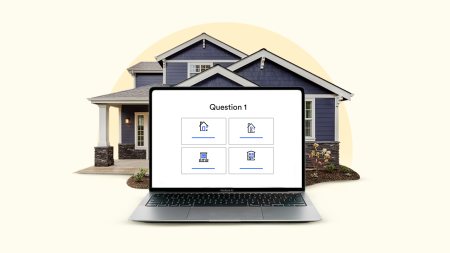Key takeaways
- Mortgage underwriting is often an automated process. Software decides whether you are approved, rejected or asked for additional information.
- Credit score is the most important factor in determining mortgage approval, but your income and debt levels, as well as the size of the loan vs. the home’s value, are also major factors.
- If your mortgage application has been denied, consider taking time to work on your financials or applying for a different type of mortgage.
For borrowers in today’s expensive housing market, getting approved for a mortgage can be a challenge. Mortgage rates have soared from pandemic-era lows, and home sale prices are at record highs, while price appreciation is outpacing wage growth.
Under these circumstances, it’s no surprise that mortgage denials are increasing. An average of more than 20 percent of mortgage applications were rejected in 2024, an increase of more than 8 percentage points over the previous year, according to the Federal Reserve Bank of New York.
Here are some of the common reasons your mortgage application could be denied — and what you can do about it.
How does mortgage underwriting work?
Mortgage underwriting is the process by which a lender verifies and analyzes your financial information — including bank statements, W-2s and other tax documents, as well as recent pay stubs — so that it may make a decision about your application.
In most cases, a loan officer or mortgage broker performs this analysis using an underwriting software system. Loans that will be sold to Fannie Mae, for example, use Desktop Underwriter (DU), while loans sold to Freddie Mac leverage Loan Product Advisor (LPA). The software determines whether you’re either approved, rejected or asked for additional information — without much in the way of human judgment.
Fannie Mae and Freddie Mac are government-sponsored enterprises that interface with lenders to keep the mortgage market stable. Between them, they buy or back about two-thirds of all U.S. home loans.
Automated underwriting, as it’s officially called, became the norm as part of the reforms to the mortgage financing world developed after the 2007–09 mortgage meltdown. “Prior to the crisis, there was more leeway,” says Bill Banfield, chief business officer at Rocket Mortgage. “Now, most of that subjectivity is gone.”
Keep in mind:
Beyond your approval or denial, the main thing the lender decides during underwriting is your mortgage’s interest rate. They also use underwriting to determine how much to charge you in fees.
Reasons for mortgage denial
“There are a thousand potential questions Fannie [or Freddie] could return,” says David Aach, chief operating officer at Blue Sage Solutions, a mortgage technology firm. “That’s the nightmare of the underwriting process.”
Here are some of the more common reasons underwriters reject mortgages.
1. You have credit issues
Your credit score is the single most important factor in determining whether you get approved for a mortgage and your mortgage rate. Generally, the best deals go to borrowers with credit scores of 740 or above.
Before applying for a mortgage, check your credit score and credit report and dispute any errors. If your credit score is low, try to boost it before you apply. And if your credit is already good, make sure to keep it that way. Try not to miss any payments, max out a credit card or apply for other new credit.
Keep in mind that, while many mortgages require a credit score of at least 620, you can qualify for an FHA loan backed by the Federal Housing Administration with a score as low as 500. And if you don’t have a credit score at all, some lenders offer alternative credit scoring methods, such as analyzing your bank deposits. In fact, in January 2025, Fannie Mae released a new update to DU in support of “increasing access to credit for populations such as those with limited or no credit histories.”
2. You have an income shortfall
Your debt-to-income (DTI) ratio — the portion of your gross (pre-tax) monthly income spent on repaying regular obligations — signals to lenders whether you’re in a position to take on an additional major debt. Most conventional lenders require a DTI of less than 43 percent, though some will accept up to 50 percent if your financial profile is strong otherwise.
There are two main ways to improve your DTI: paying off existing debt or increasing your income. Ideally, your payment obligations should take up about one-third of your income or less. Choosing a longer loan term — for example, a 30-year mortgage instead of a 15-year mortgage — will also lower your monthly payment and could increase your chances of approval.
Keep in mind that underwriting software is designed for workers who receive W-2s. If you’re self-employed, even if your earnings are high, you may be penalized for having irregular income or using alternative documentation — or for using the common strategy of maximizing tax write-offs.
“Self-employed people know what they make, but they don’t know what an underwriter is looking for,” says Tom Hutchens, president at Angel Oak, a lender specializing in non-qualified mortgage (QM) loans. “They might be fully approved, but then an underwriter looks at the tax returns” and sees that “$10,000 a month might become $5,000 a month in income.”
3. Your loan-to-value (LTV) ratio is too high
Lenders also look at your prospective mortgage balance vis-à-vis the value of the home you’re buying — something called the loan-to-value (LTV) ratio. The bigger your down payment, the less you borrow, and the lower your LTV. Generally speaking, the lower your LTV, the better.
For instance, if you’re buying a $400,000 house with a down payment of $80,000, your LTV is a comfortable 80 percent. But if you’re putting down $20,000 and financing the remaining $380,000, the LTV is 95 percent.
There are many low-down-payment mortgages these days, including government-backed and conventional options. And if you think a higher down payment would boost your application, look into down payment assistance. Every state has these programs, especially for first-time buyers.
4. You’re trying to finance an out-of-favor property
Not all homes are created equal, as far as lenders are concerned. The traditional, detached, single-family residence still rules, and you may run into trouble financing an alternative.
Condos are one example. In response to the June 2021 collapse of an oceanfront tower near Miami, Fannie and Freddie rolled out new rules covering condo loans. The giant mortgage market-makers have decided not to finance some buildings that have low reserves, need repairs or are facing lawsuits. Critics say the stricter reviews are causing condo sales to fall apart, even in buildings with no structural issues.
Manufactured homes can also be challenging to finance. And if appraisers or inspectors find a structural flaw or other issue with the home itself — no matter what type of structure it is — that can slow the approval, or even kill it.
5. Your home appraisal comes in low
Before a lender finances your home purchase, it wants to ensure that the property is worth what you’re planning to pay for it. That’s why lenders typically require an appraisal during the underwriting process.
If that appraiser determines that the property is worth less than the mortgage you’ve applied for, you have what’s called an appraisal gap.
A lender won’t agree to lend you more than it believes a home is worth. If you can identify errors in the appraisal, you may be able to get it redone — but if there’s still a gap, and you still want the property, you’ll need to make up the difference in cash.
6. Something recently changed in your financial life
The lending process prizes financial stability and predictability. Unfortunately, a recent job change or period of unemployment can throw a wrench in your approval. A short employment history or interruption in earnings sends warning signals to the software, too.
Unusual activity in your bank account can be another issue. Large, unusual deposits might indicate you borrowed money for your down payment — which you may need to repay along with your mortgage. If you got money from relatives to help you buy a house, make sure to submit a gift letter as part of your application.
7. You don’t meet the loan program’s requirements
Different types of loans come with different specifications.
If you want an FHA loan, for example, your home price can’t exceed the loan limit applicable to your location. In 2025, that’s $524,225 in most areas. The house also needs to pass a special type of appraisal that reviews the property’s condition.
Similarly, loans backed by the VA and the USDA have their own unique requirements.
On top of all of this, lenders generally have their own proprietary guidelines. Failing to meet any of them can lead to your mortgage application being denied.
8. You’re missing information on your application
Make sure to fill out the mortgage application in its entirety. If it’s incomplete — or if there are errors, such as a missing digit — the underwriting software might discard your application, resulting in an automated rejection.
How to get a mortgage after your application is denied
Take heart: If you are denied a mortgage, there are workarounds to many of these issues.
Generally speaking, government-backed loans — such as FHA or VA loans — have more flexible requirements and are a good fit for borrowers with lower credit scores or little cash for down payments.
If you have a unique income situation, such as owning a business with unsteady cash flow, you might apply for a non-QM loan. These come with more flexible credit criteria and income requirements than conventional loans.
Manual underwriting
The vast majority of conforming loans — those eligible to be bought by Fannie and Freddie — are decided via automatic underwriting, but some loans are still reviewed by a human. Lenders often do manual underwriting when an application would likely be denied through an automated system, or if the borrower has some unusual circumstances but is otherwise qualified.
Certain types of mortgages, like jumbo loans and non-QM loans, are more likely to be manually underwritten. But you can request it for any mortgage if you believe your particular situation will not be fully understood by the software. Be prepared to supply additional paperwork — financial statements reaching farther back, for example — and for a longer process. Bear in mind that, even with a manual underwriter, your loan still has to conform to specific requirements.
FAQ
Why we ask for feedback
Your feedback helps us improve our content and services. It takes less than a minute to
complete.
Your responses are anonymous and will only be used for improving our website.
Help us improve our content
Read the full article here









